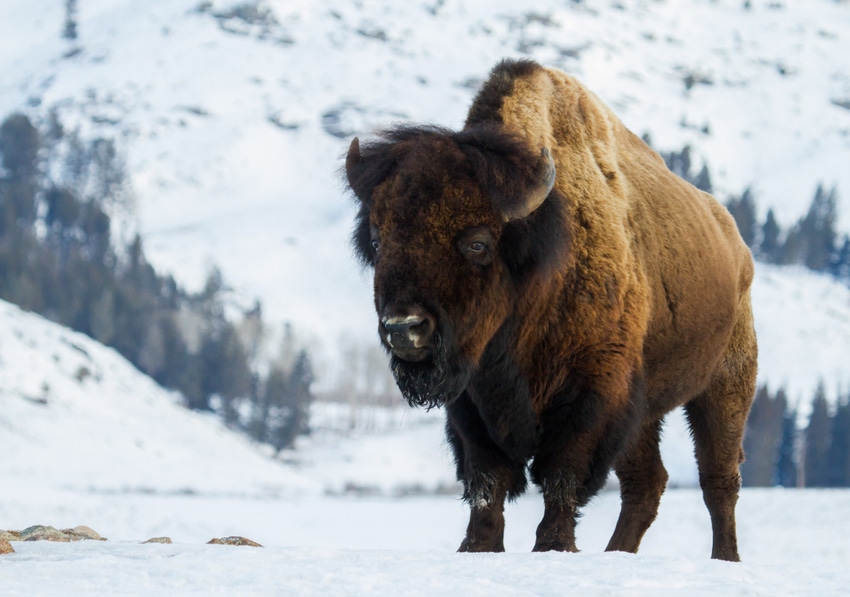Transfer of bison rumen contents to cattle improved in vitro ruminal feed digestibility.

Can rumen inocula from other ruminants alter the in vitro fermentation patterns of beef cattle? Z.X. He, G.O. Ribeiro, K.A. Beauchemin, T.A. McAllister and W.Z. Yang at the Lethbridge Research & Development Centre in Alberta recently hypothesized that inoculating the rumen of beef cattle with the rumen contents of bison and supplementing it with exogenous fibrolytic enzymes would improve ruminal feed digestibility by enhancing microbiome activity in the rumen.
The research study was recently published online in the journal Animal Feed Science & Technology.
He et al. conducted a series of three experiments as part of this study to evaluate the effects of inoculum source (cattle versus bison), inocula after transfer from bison to cattle, fibrolytic enzyme supplementation and the interactions of those factors on in vitro fermentation of barley straw, alfalfa hay and wheat dried distillers grain with solubles (DDGS).
According to the research abstract, the researchers conducted rumen content transfers in 16 beef heifers twice at a two-week interval by replacing 0.70 of total rumen contents from the heifers with an equivalent amount of mixed rumen contents collected from Plains bison.
Three experiments were conducted using batch culture techniques, He et al. said. In experiment 1, inocula were prepared by combining rumen fluids of cattle and bison at ratios of 100:0, 67:33, 33:67 and 0:100; the substrates were incubated for 96 hours for determination of gas production (GP) kinetics. In experiment 2, inocula with the same ratios as in experiment 1 were incubated with substrates in vitro for 24 hours to determine dry matter digestibility (DMD). In experiment 3, incubations were conducted for 6, 24 and 48 hours with the same substrates in four runs to compare the before versus after inocula effect.
Each batch culture was a completely randomized design without or with fibrolytic enzyme addition at a rate of 2.0 μL/g of substrate dry matter. Three different fibrolytic enzyme products (referred to as FE1, FE2 and FE3) were used, with FE1 added in experiments 1 and 2, while all three enzyme preparations were added and compared in experiment 3.
He et al. reported that asymptotic GP was not affected for barley straw and alfalfa hay, whereas wheat DDGS responded quadratically (P < 0.04) with increasing bison contents in the inocula. The rate of GP decreased (P < 0.03) for barley straw and alfalfa hay (quadratic) and for wheat DDGS (linear) with increasing bison contents in inocula (experiment 1), He et al. reported.
In vitro DMD of barley straw at 24 hours of incubation quadratically (P < 0.02) increased with increasing bison contents in inocula, whereas DMD of alfalfa hay and DDGS linearly (P < 0.01) decreased in experiment 2, according to He et al.
For experiment 3, the researchers said the DMD of barley straw, alfalfa hay and DDGS was greater (P < 0.05) at six hours of incubation with the inocula collected after, compared to before, the rumen content transfer. In contrast, the DMD of alfalfa hay at 48 hours and DDGS at 24 and 48 hours was less (P < 0.04) with inocula after versus before rumen content transfer, He et al. reported, noting that the addition of fibrolytic enzymes improved (P < 0.05) the DMD of DDGS.
He et al. concluded that the ruminal inocula from bison had an advanced capacity to degrade fibrous feed in vitro compared to those from cattle. Enrichment of the cattle rumen microbiome with that of bison could potentially improve rumen digestion of fibrous feeds in beef cattle, they suggested. Moreover, the results also indicate that the improvement in feed digestibility due to supplemental fibrolytic enzymes may be independent of inoculum source.
About the Author(s)
You May Also Like


.png?width=300&auto=webp&quality=80&disable=upscale)
